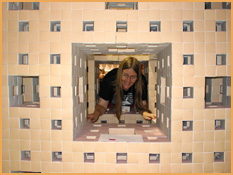Dr.
Mosely, who created this model of Menger's Sponge and shephered its
construction over the past
nine years, studied electrical engineering at MIT. She now works
in the
emerging field of computational origami, a branch of mathematics that
explores the formal properties and potential configurations of folded
paper.
Extensions:
Do not be misled
by the name of "origami." Origami can be far
more than paper art. Be reminded that William Thurston, a
Princeton University and Institute for Advanced Study 1982 Fields Medal
mathematician, liked to test his abstract ideas using construction
paper and scissors to classify three dimensional manifolds. By
experimenting, Thurston found that all possible manifolds could be
broken down into
one or more of eight types, but they had a "preferred"
geometry -now known as the Thurston geometrization conjecture.
Currently, one
of the central problems in biophysical chemistry and biophysics is
protein folding, where the goal is understanding how a linear
polypeptide
chain folds into highly symmetrical structures such as four-helix
bundles.
Origami and
protein folding are alike in that both are restrained by connectivity.
|
Dr.
Mosely first publicly presented her project to coincide with OSRME
4, the Fourth International Conference on Origami in Science,
Mathematics and Education at Caltech in September. 2006.
| Links
to Dr. Mosely's Project |

|
|
|
|
For a
biography of Karl Menger
|
For more
information on the
relationship of Thurston's manifolds to
Poincaré's Conjecture please see
S.
Naser and D. Gruber, "Annals
of Mathematics: Manifold Destiny," The
New Yorker, August 28, 2006,
pp. 44-57.
|